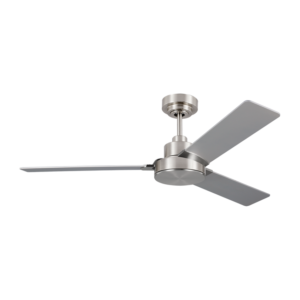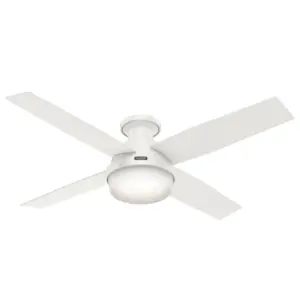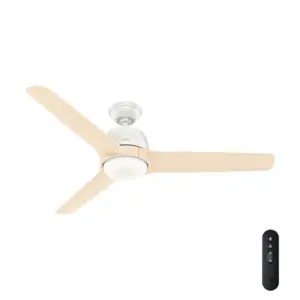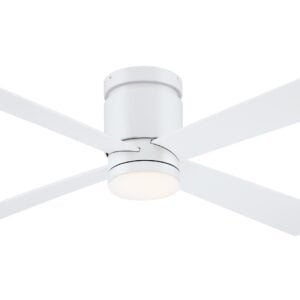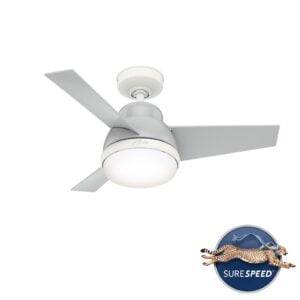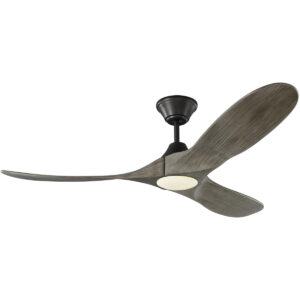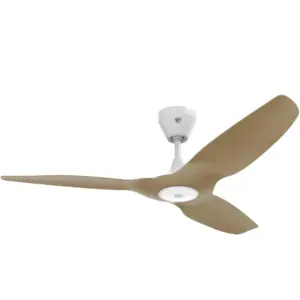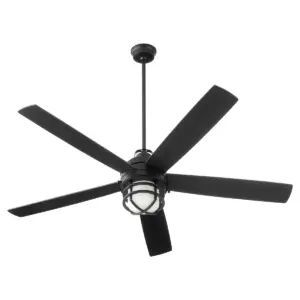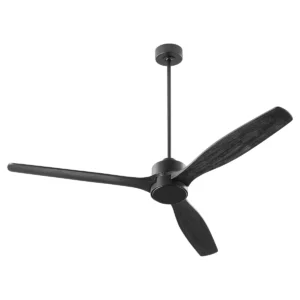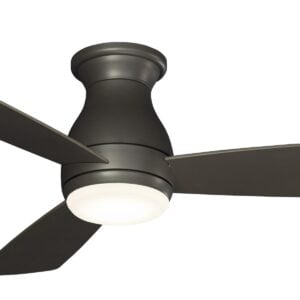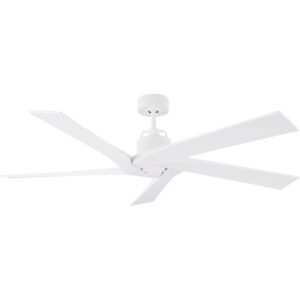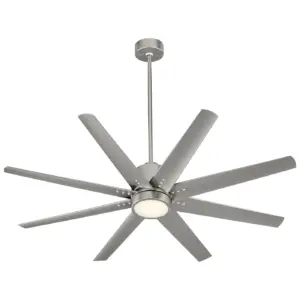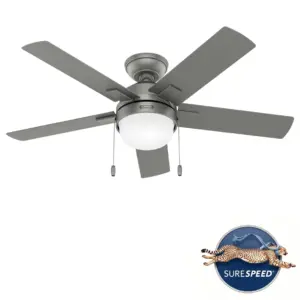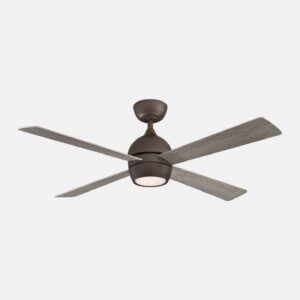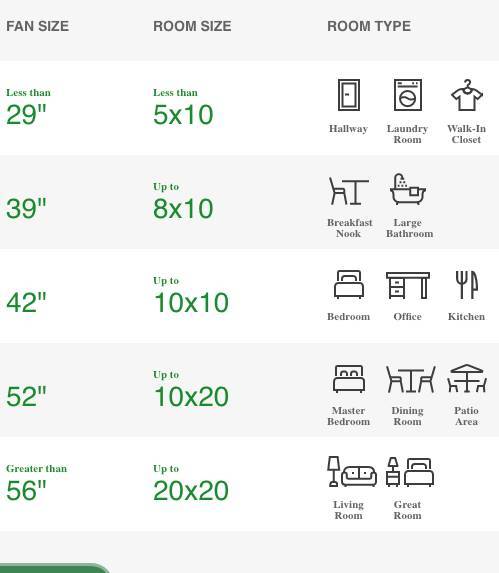Bedroom Ceiling Fan Guide
Everything You Need to Know Before You Buy
A cool, comfortable bedroom is all you really want. A bedroom ceiling fan circulates air and encourages peaceful sleep — no air conditioner required!
A quality bedroom ceiling fan will lull you to sleep with a quiet whirring sound, especially on those steamy summer nights. Whether you're replacing an old ceiling fan or want to install a new one, these are some of the features and options to look for in the perfect ceiling fan for your boudoir.
Bedroom Ceiling Fans - Steps to Making a Wise Purchase
Cooling your bedroom space is easy enough once you have the right fan, but there are a variety of ceiling fan sizes, types, styles and lighting options to choose from.
Here are some quick tips for choosing the right fan for your room:
- Set your budget
- Decide where you'll place the ceiling fan
- Choose the perfect ceiling fan size according to location
- Select a ceiling fan style
- Pick a light style for your ceiling fan
- Determine mounting type
- Look for remote control and other convenience features
- Determine airflow and efficiency needs
Before picking the ideal ceiling fan for your bedroom, you'll need to check out your bedroom's ceiling and determine where to install it. If you already have a light fixture in the center of your room, you may want to look at videos about removing and replacing the light fixture with the new ceiling fan.
Why Have a Ceiling Fan in Your Bedroom?
Temperature control: When temperatures reach new heights in the summer, your ceiling fan will create a gentle breeze that keeps your space feeling comfortable and cool. Also, in colder months, ceiling fans will push warm air from the ceiling down to the floor, resulting in a more cozy, comfortable environment.
White noise: Many ceiling-fan lovers swear by the whirring sound as a sleep aid. When noises wake us a night, the reason is they change the sound consistency we've got used to in a "sudden" manner. White noise, like that produced by a ceiling fan, creates a blanket of sound that helps mask any sudden consistency changes, leaving you to feel extra refreshed in the morning. Also, because white noise is audible, it's preferred by people who do not like sleeping in a completely silent environment.
Style and decor: Fans come in a variety of sizes, styles, and colors, with finishes that match any interior look. Your options range from traditional wood ceiling fans and brushed metal finishes to tropical fans and even industrial styles.
Energy savings: Another main advantage is that ceiling fans reduce energy costs. Since your fan helps moderate the temperature in a room—making a warm space feel cooler or cool space warmer—you won't have to run your A/C or furnace as frequently.
Ceiling Fan Size
For the best results, pick a ceiling fan size that matches your room size. If you install a fan that's too small for the room, it won't circulate a sufficient amount of air to keep you cool. Likewise, a fan that's too large would overpower the room and may be noisier than you like. Here is a quick ceiling fan size guide to help you choose the right design:
Small Rooms and Fan Diameter
If your room is 100 square feet or less, choose a smaller ceiling ranging from 30 to 48 inches. These fans may only work with smaller bedrooms, so make sure to measure your space correctly.
Large Bedrooms and Fan Diameter
If you have 400 square-foot room, then you'll want to install a medium-sized ceiling fan that has a range of 48 inches to 54 inches. These are typically the best for bedrooms.
Over 400 Sq. Ft Rooms and Fan Diameter
You'll want to pick a ceiling fan with a range between 56 inches or greater. These are large-diameter ceiling fans that work best in spacious rooms like large master bedrooms.
Ceiling Fan Styles
The best ceiling fan for your bedroom will increase your comfort but also complement your décor. An important style tip is to ensure that your ceiling fan's primary design features and colors match the main design features of your bedroom.
Whether you are looking for a ceiling fan that matches your home style or you want to stick to a budget while selecting the best ceiling fan type, here are a few of the options available.
Traditional Ceiling Fans
Traditional ceiling fans typically combine design warmth and simplicity with classic finishes like walnut brown, oiled bronze or weathered pine. This style of ceiling fan integrates well with a wide range of furniture styles and room décor. But don't let the throw-back look fool you. Many traditional ceiling fans come with the latest modern features, such as remote smartphone control.
Antique Ceiling Fan Designs
Looking for a ceiling fan to match your vintage or farmhouse decor? Antique ceiling fans often have decorative filigree designs or scrollwork on the blade brackets and motor housing. You may want to look at lighting kits with warm globe lights or even a vintage style to partner with these designs.
These fans also come in different prints, textiles, and finishes. You may choose a floral or leaf print, as well as rose gold, warm brass, and rustic copper finishes.
Modern Ceiling Fan Styles
If your space is more transitional and modern? A contemporary ceiling fan style aligns perfectly with sleek, metallic finishes, minimal designs and clean lines. You won't see too many decorative wood carvings. However, modern ceiling fans with natural textiles like cotton, linen, or wool also integrate well with contemporary interior decor, especially stainless steel or nickel hardware.
Rustic Ceiling Fans
Western, country and mission interior decor all fall under rustic styles. These ceiling fans offer dark wood finishes and unique homespun accents. Mountain-lodge furniture partners well with rustic ceiling fans boasting metal accents, hewn wood and soft or tan colors.
Tropical Ceiling Fans
A coastal, nautical or island home interior pairs exceptionally well with natural palm leaf, rattan, or bamboo ceiling fan blades. These styles typically use distressed wood finishes or tropical flower accents as well as linen or cotton materials.
Noise Level and Quiet Ceiling Fan Motors
Your ceiling fan motor should run quietly without lubrication for many years. One of the major signs of a high-quality fan is the motor quality. Weak motors have a harder time spinning blades, which can lead to a noisy fan. You also want to check the hardware design and look for strong steel in the base. You want a fan that won't wobble and knock at night after a few days of use.
Keep in mind that shorter blades tend to generate more noise. Longer blades typically spin at a 14-degree pitch, resulting in quieter operation.
Ceiling Fan Mounting Types
The typical ceiling fan is mounted at a ceiling box, which may be where your bedroom's central light fixture is located. Your light switch is typically connected to this box and allows you to control the lighting attached as well. There are several ceiling fan mounting options available:
Hugger mount
A hugger ceiling fan mounts flush to the ceiling. This mounting type is designed for rooms with low ceilings when you don't have enough space for a downrod. It's the perfect solution for bedrooms with low ceilings (8 feet or less).
Close-to Ceiling or Low-Profile Mounts
Another term for the close-to-ceiling mount is low-profile mount. In close-to-ceiling or low-profile mount installations, a downrod of 3 to 5 inches is inserted between the ceiling and the fan housing. This allows for more air circulation and greater fan efficiency while keeping the ceiling fan relatively close to the ceiling and out of the way. This mounting option works well in rooms with ceiling-to-floor heights of roughly 9 feet.
Downrod Mount
This option is best for rooms with high ceilings, such as great rooms, lofts and 2-story entryways. Using your downrod, you can lower your ceiling fan to the optimal height above the floor.
Downrod guide:
- 6-inch downrod: Best for 9-foot ceilings
- 12-inch downrod: 10-foot ceilings
- 24-inch downrod: 12-foot ceilings
- 36-inch downrod: 14-foot ceilings
- 48-inch downrod: 16-foot ceiling
- 60-inch downrod: 18-foot ceiling
- 72-inch downrod: 20-foot ceiling
When installing a ceiling fan with an extended-length downrod, you also want to consider the need for extra lead wire to work with the length of your downrod. You won't be able to connect your fan to a power source if you don't have the right length of lead wire.
Sloped Ceiling Mount
If your ceiling is vaulted or has an incline, you'll need a sloped-ceiling adapter kit to hang your ceiling fan straight. If you're purchasing a ceiling fan for a bedroom with a sloped ceiling, beware that not all ceiling fans are sloped-ceiling adaptable. Check the product details to verify the ceiling fan is compatible with a sloped or angled ceiling.
Choose Energy Start-Certified Ceiling Fans for Maximum Energy Efficiency
Make no mistake - an Energy Star® ceiling fan will save you money! On average, an Energy Star-certified ceiling fan with lights uses 60% less energy than a standard ceiling fan model.
A ceiling fan that has the ENERGY STAR Most Efficient designation is among the best of the best. When you use less energy, you save money and reduce your carbon footprint.
Key features of Energy Star-rated ceiling fans:
- They have better motors and blade designs.
- They can reverse the direction of the blade spin, changing the airflow pattern and allowing you to benefit from your fan year-round.
- Non-lighting component(s) carry a warranty for at least three years.
- Some Energy star ceiling fans offer remote Bluetooth and WiFi connectivity, so you can control them with your smartphone or voice assistant!
Energy Star-certified products are tested to meet strict efficiency specifications and are certified by an independent third party. They perform the same as or better than standard products without compromising performance in any way.
Ceiling fans are subject to Canada's Energy Efficiency Regulations, which set a minimum performance standard for their energy efficiency. Find details in the Guide to the Regulations.
Smart Technology
Handheld remote controls are awesome, but smart technology is better. A "smart" ceiling fan connects to your WiFi network. This allows you to control the ceiling fan by either tapping an app on your phone or tablet or speaking voice commands to your favourite virtual assistant (Alexa, Google Assistant or Siri).
You still get a standard remote with your smart ceiling fan, but you may end up sticking it a drawer and forgetting about it.
Some brands allow you to pre-program your ceilings fan's settings, so your bedroom's comfort level will always be just right when you retire for the evening.
Where to Place a Ceiling Fan in Your Bedroom
From a usage standpoint, the best location for a ceiling fan in a bedroom is generally the center of the room. However, whatever location you're considering, it's important that you first check to ensure the ceiling is braced for the movement and weight of your ceiling fan.
Does your room have a ceiling light fixture? Often you'll end up hanging your ceiling fan in the same spot, once the light has been removed.
Maximize Your Airflow
Your bedroom's airflow is vital for comfort and efficiency. Unless your space has an unusual shape, the best placement for maximum airflow is generally the center of the room.
If your room has an irregular shape (such as an L-shape), consider hanging two ceiling fans, each sized for the room space it serves.
The combination of precision blades and high-velocity motors in today's top-quality ceiling fans offers strong airflow that can have a substantial cooling effect.
Consider combining ceiling fans and air conditioning for even better results and a further reduction in your energy bill. If you set your thermostat two degrees higher and use ceiling fans to circulate the cool air, you can cut your home's air conditioning costs by 14 percent.
Bedroom Ceiling Fans with Lights
A ceiling fan that is light-kit compatible may use LED, halogen, incandescent or fluorescent bulbs.
Some ceiling-fan models include a light kit in the purchase price, while others give you the option to buy a light kit separately. Many ceiling fans are equipped with dimmers for more precise control of lighting intensity.
If your ceiling fan comes with a handheld or wall-mounted remote control, you will be able to manage the light settings from a distance.
Smart ceiling fans offer even more control over their light settings, including the ability to pre-program the lights to turn on and off at selected times.
Ceiling fans with LED lights are the best choice for reducing energy costs. LED lighting is 80 percent more efficient than other lighting technologies. Worth noting, LED lights also produce less heat, a happy byproduct of using less energy. So if you're installing a ceiling fan to help keep your home cool, choosing LED lighting simply makes good sense.
LED lights also have the longest lifespan, with an average of 50,000 hours.
Blade Types
Furniture-grade hardwood is the material used for most high-quality ceiling fan blades. At the lower quality levels, the blade materials are typically particle board or medium-density fiberboard (MDF). Most blades that use cotton or linen designs still have a metal or wooden frame.
For outdoor use, you should look for ceiling fans with damp or wet-rated blades.
How Many Ceiling Fan Blades Is Best?
Surprisingly, the answer to this question from an overall performance standpoint is that it doesn't really matter. At the present state of the art, the top ceiling fan manufacturers can deliver outstanding performance regardless of the number of blades.
Therefore, the main factor in deciding how many blades should be aesthetic. If you're buying a ceiling fan for a bedroom, you'll typically be looking at 3 to 5 blades to suit the dimensions of the space.
A 12-blade ceiling fan, for example, would tend to look out of place in a standard-sized bedroom. Now, if you're shopping for a large master bedroom with a vaulted ceiling, that's another story, and a ceiling fan with more blades could work well.
As far as energy consumption, Energy Star advises that a ceiling fan with four blades works just as well as a fan with five blades. Some benefits of fewer blades
Less drag. It's simple physics - the fewer the blades, the less drag on the motor. And less drag means the motor can spin the blades more efficiently and faster, creating more airflow.
Breeze vs gust. Motor size and blade length being equal, a fan with fewer blades will usually spin faster, creating more airflow. Turn the speed on high, and you might imagine you're experiencing a windy day. If you prefer your breezes to be gentler, consider a fan with more blades.
Best Ceiling Fan for a Bedroom: Installation Tips
Installing a ceiling fan isn't difficult unless you have a very high ceiling. It can take from 1 to 3 hours to install a ceiling fan, depending on assembly time, electrical wiring and downroad installment. Plan to install it during the daytime as you'll need to turn off the power to the room when working on the electrical components.
There are also other things to consider, such as whether you have the knowledge and skills to install an electrical appliance in your home. For this reason, it may be best to hire a handyman or enlist the aid of a friend to ensure safety.
What Fan Direction is Best for a Bedroom?
Summer - Counterclockwise
In the summer months, your goal is to feel cooler in your bedroom to aid your slumbers. Now, remember that a fan doesn't actually reduce the temperature of a room. Rather, it cools the occupants by circulating air. If you set the ceiling fan rotation to counterclockwise, the blades will push air downwards, and it will flow to where you are sitting or standing. The moving air causes the moisture on your skin to evaporate faster, and this creates a cooling effect.
Winter - Clockwise
In the winter, your goal is to feel warmer, snug as a bug in bed. Again, keep in mind that a fan doesn't actually increase the temperature of a room. Rather, it exposes the occupants to more of the room's warmth by circulating the air. Since warm air rises, it eventually pools at the ceiling where it doesn't do much good, and in the absence of airflow, it will remain there. If you set the ceiling fan rotation to clockwise, the blades will draw cooler air from the floor level up towards the ceiling. This rising air displaces the pooled warm air, causing it to flow away towards the walls and down to the floor, where you are.
Frequently Asked Questions
Should I put a ceiling fan in my bedroom?
There are many benefits to having a ceiling fan in your bedroom, including increased sleeping comfort and reduced energy costs. A ceiling fan can also make a bold style statement, giving your space a unique look and feel.
How do I choose the best style ceiling fan for a bedroom?
You can start by looking to your existing bedroom furnishings and finishes for ideas. If you're working with a new bedroom or searching for something different, consider seeking inspiration in the wide range of models and styles of ceiling fans that are available. Also, think about buying a ceiling fan with reversible blades. This will allow you to change the look of your fan throughout the year, keeping your decor fresh.
What's the best placement for a ceiling fan in a bedroom?
Ceiling fans are typically best placed in the center of your bedroom. This is the ideal location for maximum airflow. However, if you have a larger, open bedroom with an odd shape or size, you may want more than one ceiling fan. In this case, each ceiling fan should be appropriately sized for the room space it serves.
Key Points to Remember
The first step to buying the ideal ceiling fan for your bedroom is to measure your bedroom. This includes measuring the ceiling height so you can choose the correct mounting type. Here are some other core things to remember:
